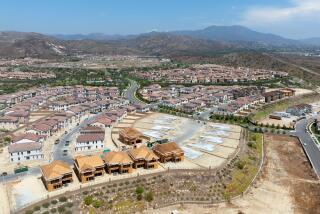Population Growth Rate Trails Region and State : Statistics: Department of Finance figures show that the county gained about 12,000 residents, placing it 46th in California.
Ventura County grew by nearly 12,000 people in the last fiscal year, but its rate of growth lagged well behind the region and the state for the third straight year, the state Department of Finance reported Tuesday.
Although Ventura County’s growth outstripped California’s in the 1980s, the county growth rate for the year ending June 30 was 1.74%, while the state’s population grew 2.13%.
The number of county residents rose from 683,700 in July, 1991, to 695,600 during 1991-92, the Department of Finance estimated.
But the state’s population swelled to 30.6 million thanks to a large increase in foreign immigrants and a higher ratio of births to deaths.
The local growth rate was 46th among California’s 58 counties. Among the other six counties in Southern California, only Los Angeles County’s 1.2% pace of growth was slower than Ventura County’s.
The new statistics reaffirm that the rapid population jumps of the 1980s are a thing of the past, County Planner Steve Wood said.
The boom of the 1980s produced average annual growth of 2.5%, with a sustained peak from 1987 to 1989, he said. But with the recession of late 1989 came a prolonged slowdown that Wood said may last this decade.
“Our forecasts show an increase of about 12,000 people per year for at least the next five years,” he said.
Such increases would equate to slowly declining growth rates, he said. But the county’s population will still grow to 724,000 by 1995 and 788,000 by the year 2000, according to county projections.
The slowdown is partly caused by job loss during the recession and by a slowdown in construction in the fast-growing east county, Wood said.
“The low that we had (in 1990) was because of the loss of jobs both in this county and in Los Angeles County,” Wood said. “Both affected workers from this county. But that may be gradually turning around now.”
Applications for construction permits also surged in the 1980s, as builders entered the review process before a spate of local growth-control laws went into effect, he said.
The new Ventura County figures also show that--contrary to earlier estimates and projections based solely on driver’s license data--more residents are moving into the county than are moving out, state analysts said.
Preliminary Department of Finance figures released in February, 1992, reported that Ventura County had grown by 8,700 residents in 1990-91, but that all of the increase came from the difference between births and deaths.
At the time, the state reported that Ventura County lost 44 residents during that fiscal year due to migration out of the county.
But department manager Elizabeth Hoag said Tuesday that the estimates were off 3,349 people and that the net migration into Ventura County was 3,305 for that year.
“Son of a gun, that is the problem with those provisional estimates,” Hoag said. “We don’t have the final counts for births and deaths when we release these figures. And migration is the hardest to predict by far.”
To predict that counties are losing their adult populations based solely on early estimates and driver’s license information is highly speculative, she said.
The Department of Finance bases its twice-a-year county and state population estimates on changes in such data as births, deaths, school enrollment, registered voters, driver’s licenses, address changes, registered autos and housing units, she said.
In Southern California, Imperial County led not only the region but the state with a 7.4% population increase. Riverside and San Bernardino counties posted the next highest rates in the region, with 4.1% and 3.4% increases, respectively. Orange County’s increase was 2.3% and San Diego’s 2.2%.
Along the Central Coast, Santa Barbara County grew 1.6% and San Luis Obispo County 2.0%.
County Growth The population continues to increase in Ventura County, but at a slower pace than in the 1980s.
TOTAL YEARLY PERCENT OF FISCAL YEAR* POPULATION INCREASE INCREASE 1991-92 695,600 11,900 1.74% 1990-91 683,700 12,100 1.80% 1989-90 671,600 9,600 1.45% 1988-89 662,000 17,000 2.64% 1987-88 645,000 18,000 2.87% 1986-87 627,000 15,800 2.59% 1985-86 611,200 14,300 2.40% 1984-85 596,900 12,700 2.17% 1983-84 584,200 12,100 2.12% 1982-83 572,100 12,600 2.25% 1981-82 559,500 14,600 2.68% 1980-81 544,900 12,700 2.39%
* Fiscal year runs from July 1 to June 30
Source: California Department of Finance
More to Read
Sign up for Essential California
The most important California stories and recommendations in your inbox every morning.
You may occasionally receive promotional content from the Los Angeles Times.









